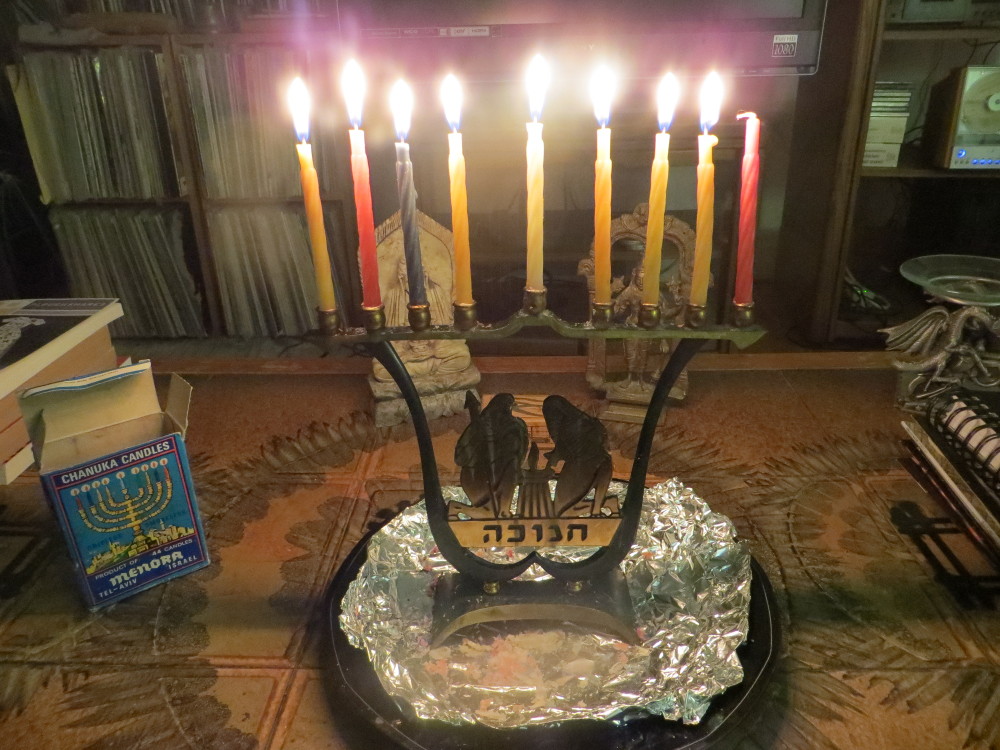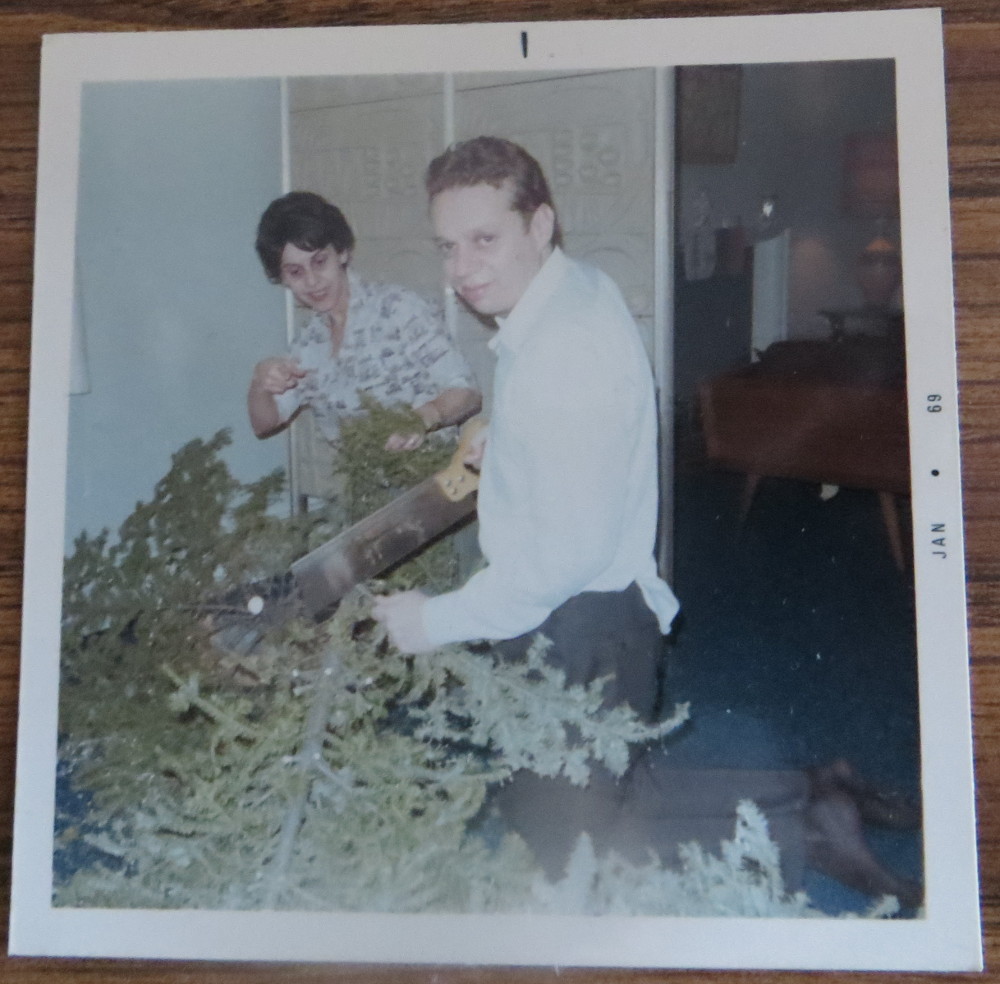
I don’t usually celebrate Hanukkah, but this year it somehow felt like the right thing to do.
As I lit the first night’s candle from the shamash center candle, I said, devoutly, “for you, Mom and Dad.” It seemed a little ridiculous, for Dad’s sake, as he was a devout agnostic. But he died last year, just a few days into the Jewish Festival of Lights, so this holiday will be forever linked with his passing.
I was with him, in the hospital, in his final days. He had grown confused, though he had some lucid moments when he seemed his old snarky self, such as when a gentleman came in to speak with us, to see if we were satisfied with the care he was receiving. At the end of his visit, he moved very close to Dad, leaning in so he could hear him, and told him that he had to be strong and pull through, as it would be unappreciative of god not to do so.
Fortunately, Dad didn’t hear him, and when the man left, he asked,” what did he want?” I replied, “he was asking what you thought of the care you’re receiving — with a little missionary work on the side.” Dad laughed, and I was grateful for the opportunity to provide a rare moment of levity in the most dire of circumstances.
The menorah is old. I remember it from my childhood, when Mom was younger and healthier, and she would light it, in a noble attempt to honor our Jewish roots. Around the same time, I was sent to Sunday school. Although well meaning, this practice was soon abandoned, when it became apparent that neither of them had any intention or desire to attend synagogue, not even on the High Holy Days. Being rebellious, I was quick to point out the hypocrisy.
The menorah is also unstable, and it occurs to me that this probably isn’t a good idea, with multiple burning candles haphazardly stuck into small wobbly candle holders. But it represents our family dynamic perfectly — elegant and kindhearted, yet fragile and flawed.
The candles are old, too, judging from the 1970s-style graphics on the box. They’re special “Chanuka candles,” direct from Israel, 44 of them. It’s an odd number, but that’s exactly what is needed to celebrate properly for the full eight days. Although, when I counted them, I discovered there were only 43. What happened to candle #44? It seemed quite odd that someone would open the box and use one candle. This made me chuckle, especially when I heard softly in my head, “a day late and a candle short.” That was Dad’s humor, cynical and self-deprecating, and my heart soared at the thought that he was there in the room with me. Maybe Mom was also watching as I resurrected an old family tradition.
I took in the scene of the slowly dwindling candles, with my Tibetan Buddhist statues standing guard in the background. That seemed fitting as well.
On each night, as I babysat the burning Hanukkah candles to ensure that I didn’t start a fire, vague memories of holiday celebrations trickled in, like wisps of smoke as each thin candle slowly extinguished.
For each night of the holiday, there would be small gifts, as is the custom. One I recall was a little sack of milk chocolate coins in shiny gold tin foil covering. At times, we would visit my aunt, uncle and cousin, who lived nearby, though that was typically for the Passover Seder, a more structured affair. Following copious amounts of wine and an attempted read through of the ceremony, gifts would be hidden around the house, which the kids (my cousin and I) would try to find.
In my early childhood, I was envious of those who got to have beautifully decorated Christmas trees. One year, my parents went out and bought one. When it came time to dispose of the tree, they were too embarrassed to put it out for the trash, as people do, since we lived in a predominantly Jewish neighborhood. So, my enterprising father cut it up and burned that sticky, sappy pine tree in the fireplace, filling the house with dense smoke. This incident became a favorite family holiday story.

Two Jews trying to make a large Christmas tree disappear.
It just so happened that at the time of Hanukkah this year, I was reading a book I had purchased as a gift some years ago for Dad, but never read myself — “The Lower East Side Jews,” about the Jewish immigrants who came to New York City from Russia in the late 19th century. They were escaping the Russian pogroms. The story follows Abraham Cahan, a key figure in the Jewish socialist and labor movements, and editor of The Forward. Simultaneously, I had just discovered a rather brilliant Amazon Prime TV series, “The Marvelous Mrs. Maisel,” about an Upper West Side Jewish husband and wife and their family, which takes place in 1958. They have what seems like the perfect life, except that they don’t (dysfunctional Jewish family, a perennial theme), and it’s also the tale of a woman’s journey of self-discovery. Suffice it to say, it was a mystical convergence.
I think it was a combination of the two that was so perfect for me. There was the literary discussion of Jewish laborers and the first American unions, the Yiddish theater and Yiddish press of the Lower East Side, where my grandparents ran a luncheonette on Second Avenue, on the same site where Veselka serves up blintzes and borscht to this day. And then a spot-on portrayal of New York Jewish culture with the crazy shenanigans and banter of the Maisels, who reminded me of family get-togethers in Brooklyn, Queens and Long Island in the 1960s.
They say that one becomes more religious as one gets older. It must be the realization of one’s mortality and I suppose the sudden need to “hedge one’s bets.” Though I don’t think Mom felt that way, and Dad, if anything, became even more of an agnostic in later years. As for me, it’s just that the sight of the menorah and the vintage box of Hanukkah candles makes me think of family, and an earlier, simpler time. It’s a fond nostalgia that tastes of bagels, lox and cream cheese.
Mazel Tov!
share this:
Leave a Reply